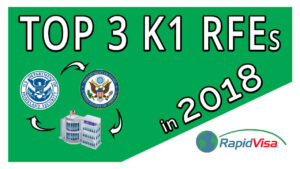How to avoid—and manage—this common challenge in the green card process
Overview of the USCIS Request for Evidence Process
If you thought you were done with the marriage green card application, receiving a Request for Evidence (or “RFE”) from U.S. Citizenship and Immigration Services (USCIS) can be frustrating and even scary. But don’t panic!
An RFE does not mean that your application is going to be denied or even that it is more likely to be denied than if you hadn’t gotten the RFE. An RFaE, as the name suggests, is simply a request for more documentation. It means that the USCIS officer reviewing your application needs more information before he or she can make a decision.
Think of an RFE as a second chance to review your application and ensure that you have provided the most compelling evidence that your marriage is real, and that you or your spouse are eligible for a marriage-based green card.
It is very important that you respond to the Request for Evidence and provide as much of the requested evidence as possible by the deadline indicated on the notice. If your RFE requests more than one document, you have to send everything together in one response packet. If you don’t meet the deadline, USCIS will make a decision based on the information and documents it already has, and that often means your application will be denied.
How to avoid RFEs
The best way to handle a USCIS Request for Evidence is to avoid getting one in the first place. Even though an RFE does not necessarily mean that your application will be denied, it will always result in additional delays. In most (but not all) cases, RFEs can be avoided with a thoroughly prepared application.
In general, RFEs are sent any time the USCIS officer reviewing your application needs more information—but there are a few specific reasons that are especially common:
1. Missing Initial Evidence
If you failed to provide any documents, forms, or other evidence necessary to prove that you’re eligible for a marriage-based green card, you will likely get an RFE. And that’s a good thing—certainly preferable over USCIS outright denying an application that was missing required initial evidence.
2. The Sponsoring Spouse Lacks Sufficient Income
When applying for a marriage-based green card, the U.S. citizen or green card holder has to demonstrate enough financial resources to support the family in the United States (typically by earning at least 125% of the federal poverty line). Failing to provide enough documentation to prove sufficient income is a common reason for RFEs.
If the sponsoring spouse doesn’t earn enough, he or she can find a co-sponsor—often a family member—who agrees to support the couple in the United States. You can see our handy guide to find out if you meet the financial support requirements.
3. Missing Proof of Legal Entry
If the spouse seeking a green card is already within the United States, you must prove that he or she entered the United States legally.
For most people, this means providing a copy of your stamped passport and/or a copy of your I-94 travel history, the form that U.S. Customs and Border Protection (CBP) uses to track arrivals and departures.
If you arrived in the United States by plane or boat before April 2013, you got a paper I-94. You also still get a paper I-94 if you if you enter the United States by land from Canada or Mexico.
If you arrived by plane or boat after April 2013, however, your information was entered into a database and you didn’t get a physical slip of paper. In that case, getting a copy of your I-94 online is relatively easy.
If you lost your original I-94 and your records aren’t available on the CBP website, you can file Form I-102 to request a replacement I-94.
4. Missing Document Translations
If any of your documents are in a language other than English, you must provide a translation made by someone other than you or your spouse. These translations have to be certified, which just means that the translator must certify in writing that he or she has translated the document accurately. The certification should include the translator’s name, address, and signature, as well as the date the translation was completed.
5. Unusual Cases
If there are any unusual aspects of your case, provide additional explanations or evidence to pre-empt questions from USCIS. For example, if you previously applied for a green card for someone else (an ex-spouse), but ended up withdrawing your green card application, you should include a written explanation of that situation.
What to do if you receive a Request for Evidence
The first step in responding to an RFE is to read the entire RFE carefully. Check out this guide to understanding each part of the RFE. You will typically only get an RFE once, which means you have this one chance to respond to any and all remaining questions that USCIS has about your application.
Next, you should review your original application package. USCIS officers are human, and sometimes they request information that you have already provided. If this is the case, you can photocopy the relevant documents from your original application package to include in your RFE response.
Then you’ll need to prepare your response package, including the following items:
- Your original RFE notice (NOT a photocopy) should be the first page of the response package.
- You only get one response to an RFE, so if there are several documents requested you need to send them all, together, in one package.
- If there are documents you’ve photocopied from your original application, you should note that they came from that original application.
- Provide any necessary explanations. For example, if your birth certificate is bilingual (and one of the languages is English), but you are asked to submit a translation, you can point out that the birth certificate is already in English.
If there is any document requested in the RFE that you can’t provide, you should explain why you don’t have access to it, and provide alternative evidence if possible. For example, you or your spouse might have trouble getting a copy of your birth certificate because a fire or other disaster destroyed the records. In that case, you should include a letter from the records office that would normally have your birth certificate explaining why that record is not available. You should also include a sworn statement (formally known as an “affidavit”) from a family member confirming the date and place of your or your spouse’s birth.
Lastly, returning the documents by the USCIS-imposed deadline is extremely important, as is good recordkeeping. You should photocopy your entire RFE response package, including the original RFE notice. When you mail it back to USCIS, make sure you have a way to track the package and confirm that it was delivered, and keep this proof of delivery with your photocopied RFE package.
Remember: A Request For Evidence is one more opportunity to make the case that you qualify for a marriage-based green card. If you’ve received an RFE, take enough time to prepare a thorough response and round up all of the requested documents.


